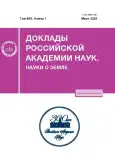STABILITY OF CARBONATES DURING SUBDUCTION: INFLUENCE OF THE DEHYDRATION REGIME OF CHLORINE-BEARING METAPELITE
- Authors: Sokol A.G.1, Kruk A.N.1, Koz’menko O.A.1, Palyanov Y.N.1
-
Affiliations:
- Institute of Geology and Mineralogy, Siberian Branch of the Russian Academy of Sciences
- Issue: Vol 509, No 1 (2023)
- Pages: 50-55
- Section: MINERALOGY
- Submitted: 14.10.2023
- Published: 01.03.2023
- URL: https://journals.rcsi.science/2686-7397/article/view/135744
- DOI: https://doi.org/10.31857/S2686739722602381
- EDN: https://elibrary.ru/THTDZE
- ID: 135744
Cite item
Full Text
Abstract
It was shown that at a pressure of 3.0–7.8 GPa and a temperature of 750–1030°C, a set of reactions occurred in carbonate-bearing and Cl-enriched pelite that is finally converted into eclogite-like assemblage and formed H2O–CO2 Cl-enriched fluid. The eclogite-like assemblage remains stable when P-T conditions change concordantly with hot subduction geotherms, whereas carbonate is completely dissolved in the fluid already at ≥5.5 GPa. In quenched fluid the content of CO2 reaches 30 wt. %. However, preliminary defluidization of pelite at 3.0 GPa and 750°С leads to chlorine removal and carbonate stabilization at 5.5 GPa and at 7.8 GPa in equilibrium with the next chlorine-free portions of fluid. Thus, the stability of carbonates under P-T conditions typical of subduction zones is dependent on the behavior of chlorine during defluidization of marine sediments.
Keywords
About the authors
A. G. Sokol
Institute of Geology and Mineralogy, Siberian Branch of the Russian Academy of Sciences
Author for correspondence.
Email: sokola@igm.nsc.ru
Russian Federation, Novosibirsk
A. N. Kruk
Institute of Geology and Mineralogy, Siberian Branch of the Russian Academy of Sciences
Email: sokola@igm.nsc.ru
Russian Federation, Novosibirsk
O. A. Koz’menko
Institute of Geology and Mineralogy, Siberian Branch of the Russian Academy of Sciences
Email: sokola@igm.nsc.ru
Russian Federation, Novosibirsk
Yu. N. Palyanov
Institute of Geology and Mineralogy, Siberian Branch of the Russian Academy of Sciences
Email: sokola@igm.nsc.ru
Russian Federation, Novosibirsk
References
- Plank T., Manning C.E. Subducting carbon // Nature 2019. V. 574 (7778). P. 343–352.
- Dasgupta R. Ingassing, storage, and outgassing of terrestrial carbon through geologic time // Rev. Mineral. Geochem. 2013. V. 75 (1). P. 183–229.
- Plank T. The chemical composition of subducting sediments. Treatise on Geochemistry 2nd Edition, Elsevier, 2014. P. 607–629. https://doi.org/10.1016/B978-0-08-095975-7.00319-3
- Schmidt M.W., Vielzeuf D., Auzanneau E. Melting and dissolution of subducting crust at high pressures: the key role of white mica // Earth Planet. Sci. Lett. 2004. V. 228 (1–2). P. 65–84.
- Hermann J., Spandler C.J. Sediment melts at sub-arc depths: an experimental study // J. Petrol. 2008. V. 49 (4). P. 717–740.
- Перчук А.Л., Сердюк А.А., Зиновьева Н.Г., Шур М.Ю. Плавление и минеральные парагенезисы глобального субдукционного осадка, обогащенного водой, в условиях закрытой и открытой системе: эксперимент и термодинамическое моделирование // Геология и геофизика 2020. Т. 61 (5). С. 701–724.
- Grassi D., Schmidt M.W. The melting of carbonated pelites from 70 to 700 km depth // J. Petrol. 2011. V. 52 (4). P. 765–789.
- Kelemen P.B., Manning C.E. Reevaluating carbon fluxes in subduction zones, what goes down, mostly comes up // Proc. Nat. Acad. Sci. 2015. V. 112 (30). P. E3997–E4006.
- Connolly J.A., Galvez M.E. Electrolytic fluid speciation by Gibbs energy minimization and implications for subduction zone mass transfer // Earth Planet. Sci. Lett. 2018. V. 501. P. 90–102.
- Newton R.C., Manning C.E. Experimental determination of calcite solubility in H2O-NaCl solutions at deep crust/upper mantle pressures and temperatures: Implications for metasomatic processes in shear zones // Am. Min. 2002. V. 87(10). P. 1401–1409.
- Facq S., Daniel I., Montagnac G., Cardon H., Sve-rjensky D.A. Carbon speciation in saline solutions in equilibrium with aragonite at high pressure // Chem. Geol. 2016. V. 431. P. 44–53.
- Sokol E., Kokh S., Kozmenko O, Novikova S., Khvorov P., Nigmatulina E., Belogub E., Kirillov M. Mineralogy and geochemistry of mud volcanic ejecta: a new look at old issues // Minerals 2018. V. 8 (8). P. 344.
- Рябчиков И.Д., Орлова Г.П., Каленчук Г.Ю., Ганеев И.И., Удовкина Н.Г., Носик Л.П. Взаимодействие шипнелевого лерцолита с водно-углекислым флюидом при 20 кбар и 900°С // Геохимия 1989. № 3. С. 56–62.
- Palyanov Y.N., Kupriyanov I.N., Khokhryakov A.F., Borzdov Y.M. High-pressure crystallization and properties of diamond from magnesium-based catalysts // CrystEngComm 2017. V. 19. P. 4459–4475.
- Sokol A.G., Borzdov Y.M., Palyanov Y.N., Khokh- ryakov A.F. High-temperature calibration of a multi-anvil high pressure apparatus // High Pressure Research. 2015. V. 35 (2). P. 139–147.
- Keppler H. Fluids and trace element transport in subduction zones. Am. Min. 2017. V. 102 (1). P. 5–20.
- Manning C.E., Frezzotti M.L. Subduction-zone fluids // Elements 2020. V. 16 (6). P. 395–400.
- Métrich N., Wallace P.J. Volatile abundances in basaltic magmas and their degassing paths tracked by melt inclusions // Rev. Mineral. Geochem. 2008. V. 69 (1). P. 363–402.
- Kawamoto T., Yoshikawa M., Kumagai Y., Mirabueno M.H.T., Okuno M., Kobayashi T. Mantle wedge infiltrated with saline fluids from dehydration and decarbonation of subducting slab // Proc. Nat. Acad. Sci. 2013. V. 110 (24). P. 9663–9668.
- Kumagai Y., Kawamoto T., Yamamoto J. Evolution of carbon dioxide-bearing saline fluids in the mantle wedge beneath the northeast Japan Arc // Contrib. Mineral. Petrol. 2014. V. 168 (4). P. 1–13.
Supplementary files










